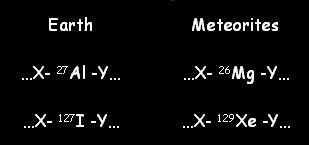| Half-Life | Years | C14 Remaining |
| 1 | 5,730 | 50.0% |
| 2 | 11,460 | 25.0% |
| 3 | 17,190 | 12.5% |
| 4 | 22,920 | 6.3% |
| 5 | 28,650 | 3.1% |
| 6 | 34,380 | 1.6% |
| 7 | 45,840 | 0.8% |
 The
basics of radiometric dating
The
basics of radiometric dating The
basics of radiometric dating
The
basics of radiometric dating
| Half-Life | Years | C14 Remaining |
| 1 | 5,730 | 50.0% |
| 2 | 11,460 | 25.0% |
| 3 | 17,190 | 12.5% |
| 4 | 22,920 | 6.3% |
| 5 | 28,650 | 3.1% |
| 6 | 34,380 | 1.6% |
| 7 | 45,840 | 0.8% |
|
Radioactive Isotope
(Parent)
|
Product
(Daughter)
|
Half-Life
(Years)
|
|
Samarium-147
|
Neodymium-143
|
106 billion
|
|
Rubidium-87
|
Strontium-87
|
48.8 billion
|
|
Rhenium-187
|
Osmium-187
|
42 billion
|
|
Lutetium-176
|
Hafnium-176
|
38 billion
|
|
Thorium-232
|
Lead-208
|
14 billion
|
|
Uranium-238
|
Lead-206
|
4.5 billion
|
|
Potassium-40
|
Argon-40
|
1.26 billion
|
|
Uranium-235
|
Lead-207
|
0.7 billion
|
|
Beryllium-10
|
Boron-10
|
1.52 million
|
|
Chlorine-36
|
Argon-36
|
300,000
|
|
Carbon-14
|
Nitrogen-14
|
5715
|
|
Uranium-234
|
Thorium-230
|
248,000
|
|
Thorium-230
|
Radium-226
|
75,400
|
Example: The radioactive element carbon-14 has a half-life of 5750
years. The percentage of carbon-14 present in the remains of plants and animals
can be used to determine age. Roughly how old is a skeleton that has lost 90% of
its carbon-14?
Solution: After 3 half-lives, 1/8-th (1/2 x 1/2 x 1/2) or 12.5% of carbon-14 should remain, so the
age is just over 3 half-lives or 5750x3=17250 years.
Example: A young-Earth research group reported that they sent a rock
erupted in 1980 from Mount Saint Helens volcano to a dating lab and got back a
potassium-argon age of several million years. This shows we should not trust
radiometric dating, right?
Solution: Wrong! The potassium-argon method, with its long half-life of 1.3
billion years, should not be used to date rocks that are only 25 years old.
These people have only succeeded in correctly showing that one can fool a single
radiometric dating method when one uses it improperly. The false radiometric
ages of several million years are due to parentless argon, as described here,
and were first reported in the literature some fifty years ago. Note that it
would be extremely unlikely for another dating method to agree with these bogus
ages. Getting agreement between more than one dating method is a recommended
practice.
Page last modified: